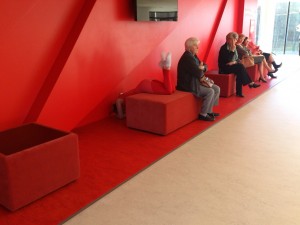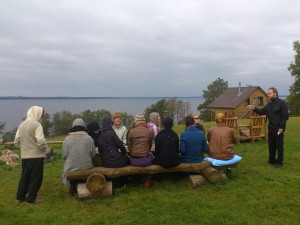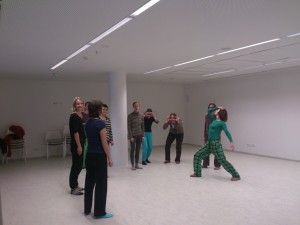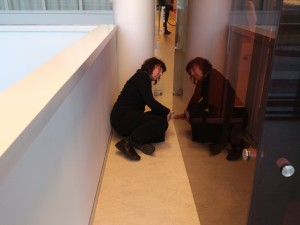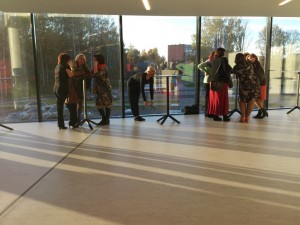BEFORE and AFTER: comments from the participants of the New Dance into the New Venue 2013
It is a year since the first seminar/festival/lab called “New Dance into the New Venue” took place in Rēzekne (east of Latvia). It all started as part of Writing Movement local labs series and was initially planned as a workshop for writers, journalists, teachers, organizers who meet contemporary dance quite often but it is not their field of expertise. Who would guess then that the lab will turn out as a week long festival with around 800 audience members next to over 40 participants. Who would guess that the project will turn into a successful formula which got already repeated this year in another new venue in Cēsis and there is a hope that there will be more reasons to continue. Good continuations demand some analysis of the past, that’s why this seems a right moment to share some of the participants’ comments we got in October 2013.
On the first day of the lab (October 2 , 2013) participants were asked to answer 2 questions. Here are some of the answers (translated from Latvian by Aija Uzulēna).
1. What do I think of contemporary dance at this moment?
– It often delights and inspires me, but it also confuses and annoys. I think that it is often so personal and conceptual that the work remains unperceived without the knowledge of artist’s biography and inquiry into his or her interests. But an inexplicable connection to a piece may also appear without all this background knowledge, just as well. I think that contemporary dance is one of the languages of our era, along with new technologies, globalization and so on. In order for new words and stories to appear, this language must keep being used and taught.
– Contemporary dance is possible because of loss of any borders, in-grained within generations, because of exploding or leaving the limits of (expected) acceptable frame. It is cool. It is difficult to remain contemporary, however, if the social environment is with its assumptions (conditions), its the desirable view of things; that is why I think that this dance has more options of expression in urban environment, as it is possible to find more like-minded people in this area. I accept and like the forms of movement used to work in this direction of art, but, altogether, it is more or less compiled from everything, therefore, seems to have existed since long ago. I have observed that, in terms of movement, this dance could be the most engaging for me. However, I do not completely understand the ideas it projects; many of its elements seem to be addressed to un-thinking ‘critical mass.’ Thus, for me as thinking individual it is boring, sometimes, or I get sense that this dance is not meant for me. But it is enchanting that such a revolutionary moment/aspect exists in Latvian culture/art, because, it helps, nevertheless, to accept, as they say that there are ‘as many daughters, as there are dresses’, as many heads as there are opinions, and they are all fine.
– Contemporary dance:
– free, improvised movement
– Sense / perception of world through the body
– Mixture of different styles of dance
– Freedom in movement, emotions, and take on the world, in life, relationships and art
– Creative expression of movements
– Part of theater
– Contemporary dance can excite, captivate and create emotional connection as well as make you think: and what do we have right here? Is it dance after all? In my opinion, the most valuable thing in contemporary dance is its diversity. I am fascinated by theater of Pina Bausch, and I particularly like her senior dancers. It is something special – wisdom, experience and movement. I remember, in an Estonian piece of contemporary dance [“Old Buddies” by ZUGA], they engaged me with their story of friendship and understanding… When 4 or 5 dancers tried to find their place and balance on a revolving small platform.
– Contemporary dance is still a mystery unrevealed. A secretive and therefore interesting mystery. Recalling what I have heard, in order to learn more about something and for an idea to occur on ‘what does it mean for me’, it must be seen, and, often – felt!
– To quote Olga [Zitluhina – Latvian choreographer, one of the teachers in the lab], contemporary dance is the poetry of the body. In my view, contemporary dance is a whole organism consisting of the basis, technique from classic ballet, while, refusing the limitations of movement and strict academic forms. For me, contemporary dance is associated with impulse, which can be brought on by emotions, to be visualized by body. This impulse can arise in a part of body, atypical part of the body can become4 the leading one. It is dance maximum can be achieved by minimum of muscle force, but, rather, by liberation and momentum.
2. What are my expectations for this week?
– In this week, I would like to ‘dissect’ contemporary dance a little bit, to learn more of its detail and, then, to put it all back together again, in the end, to gain a fresher, more colorful image of dance.
– I think I want to learn more about this current of dance during this week, it will be helpful!? Or perhaps it will not. But I hope that a sense that it is ‘bull’ will leave me forever. Because, we accept and get used to what we learn more about, so, who knows, maybe in 5 days time my answers to these questions will slightly differ.
– Creative atmosphere, insight into dance as a whole and – contemporary dance, in particular, through theoretic and visual examples. Experience of new contemporary dance performances; time well-spent in non-habitual environment and the rhythm of the day; impressions, new people met.
– In this workshop, I expect from my body-sense that it will understand the movement of contemporary dance. And, mainly, I wish to learn more about movement used by choreographers in contemporary dance.
– I expect experience, feeling, conversations, which I also receive! Thank you!
– Already the first day spent here has brought a pleasant sense that my perception of dance is widening. It is an opportunity to meet internationally wide range of people who are full of ideas. This week could be one of combining the pleasant with the useful – of seeing what is going on around, how the idea of ‘’new dance in a new place’ implements itself, as well as enjoy participation in and experience of dance all week long.
And once the lab was almost over we asked again (On October 5, 2013). This time there were three questions and more people wanted to answer no matter how tired everybody was.
1. Anything new you have learned about contemporary dance.
– Contemporary dance is not singularly a product of brain, the impulses come from the body, which, naturally, is not something never heard before, but this process is better grasped by trying it out ‘on yourself’. Synchronization is possible in body and mind, giving impulses to each other, thus, revealing that movement can be understood not only by mind, but it can also be simply sensed.
– For me, the most important was the over-all atmosphere of the work-shop – unified, friendly, and creative. And the movement, which enables us to understand better what we, normally, observe from our places in audience as the viewers of dance. Philosophical aspect was also to the point, as thinking is part of dance as well.
– Perhaps I did not know yet that contemporary dance class can be ‘opened’ the way it occurred in GORS. It was an excellent discovery for me that a highly professional class of contemporary dance can be held for an open group without the limitations of prior preparation and professionalism. Keyword: Openness. Mode of inter-action of theoretic professionals and practitioners – campsite, writing workshop – even if it is approbated elsewhere, is novel to me and very strengthening and inspiring; mainly, because it opens space and time for informal communications and, obviously, for intensive contact with the ‘matter’ of dance.
– My concept of dance and contemporary dance is ordered now.
– A new depth in emotional, anatomical, theoretical, philosophical aspects of dance.
– Working as a dancer I am always searching and discovering new things about contemporary dance. One new „connection” for me as a teacher in contemporary dance was that I have never connected old people and contemporary dance. For some reason, which I don’t know, that has never occured to me. So it was a very special moment for me when I had 3 people in their 70ties in my class – and really enjoying themselves. Annemari’s theory was very interesing and completely new for me.
2. Description of a particular movement, phrase, situation?
– Beginning to sense every bone in your body, from your spine to your legs, the body begins to be sensed not only instinctively, but along with its location in space and time, and every movement of the body can be felt as a physical harmony.
– A movement, which surprised me was Annemari’s exercise with the ball – it is inflated by about 5 cm, you sit on it, keeping the back straight, and then you begin balancing on it. The exercise does not require effort, there is even a bit of fun in it, but the result is surprising – once you put the ball aside and sit down on the floor, you begin to feel your hip bones push into the floor very clearly. And you sense that muscles on your back are thoroughly warmed as well, when you do plies. Thus, a huge effect is achieved with minimum effort.
– The physical flow of performance events is interrupted in the middle, to re-order for the next phase in its action. In this inter-play, one of the dancers addresses one of the musicians first, agreeing with him on playing a little waltz next, then, he turns to Mr. X – a man in the audience who should come in as the third in order for the number of men to pair with that of the women; X bares his feet, to be on the same physical level that the dancers are and joins the other two; and a three – pair dance evolves gradually, where a rhythmical change of pairs, accompanied by ages old, simple musical motive, presents a story, told in language of dance, which is one about possibility and impossibility to find a shared rhythm, which could bring you through the space named life.
– Balletbodylogic – – balance the body by finding equilibrium and gaining stability! Then, you are free for anything. Relaxed and dynamic – slightly confusing, but with a huge coefficient of practical usefulness, as it will always produce something good/original, and note-worthy – because gravity is doing all the work. Ballet concept gets bent. Flexion switches on, which replaces the unnaturally exaggerated extension. Very inter-exchangeable or are one and the same (as it involves natural; neuromuscular principles as in physiotherapy PNF.
– Slowness and calmness of movement. Even, raising your hand slowly, without jerking, but while sensing entire body. From how the feet dig into/connect with the ground to the loop from the head.
– Tend to take my body too seriously so Kristina’s exercises and watching Olga play around all the time gave me a hint on where I head.
3. What will stay with you after the work-shop? What will you take along from it?
– a. I will try to use Annemari’s exercises, especially – accordion. b. Inspired from the lectures of Max, I will try to avoid unnecessary snobbism in my assessments of ideas of works and their realization. C. Ingrida’s method for analyzing contemporary art.
– In my work as a radio journalist, the work-shop will lend me deeper understanding of contemporary dance. I once prepared, for example, a review of jazz dance, and I observed a rehearsal prior to that, but I think I have understood it in full only now, thanks to Kristina.
– Affirmation of my intuition that a project is born from some sprouts, while, sprouts arise from any kind of shared practice, dialogue and from combination of both: practice-reflection.
– The info crashed into my brain as a comet (long-awaited one) and left a crater – large and open. My mind is more open and not only regarding the Contemporary, but more – speaking of everyday. It has become meaningful. The mind has changed, not only in the context of Contemporary, but also in that of work, of everyday process and in the context of surrounding and inner environment. The everyday is more meaningful. My present-day feeling is – contemporary dance opens your mind and does it in a very good – nice – healthy and totally enlivening way – by movement.
– I found the possibility to meet and get to know so many culture-related people and to see performances very valuable; and, of course, this was a chance to see the new concert hall, which would not come about, most probably, without this project; and, altogether, it was a time well-spent, a getting-away from the everyday.
– It is not the history, theory, which is so complicated, but – how it can be grasped in the modern context. Connection to the viewer. In relation to them. A sense of security; everything is more many-fold, many-layered – and perhaps I am able to perceive at least one of those layers.
– „Treat everything as if you do/see it for the first time” – came back in Kristina’s class when we moved partner’s body parts to make sounds.. coming down from the universe. Max: FAKE proffessional bullshiters; „ You cannot bullshit the regions”. „Cities should be for good living not showing off”.
– A lot of things and more will probably come to me when I have digested this whole week. I will defientely try and put my feet in the water more often! I found Max’s lectures very inspiring and I am planning on reading some of the books and sources he mentioned. May be in the future I would like to give it a go as a dance critic. I could start slowly in the Faroe Islands. The people i have met here will hopefully open up for further work together on contemporary dance.
